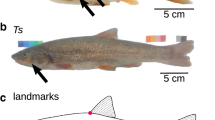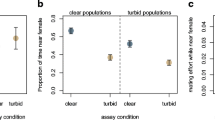Abstract
Atlantic mollies (Poecilia mexicana) inhabit a variety of surface habitats, but they also occur in a sulfur cave in southern Mexico. We examined male mate choice relative to female body size in the cave population and in the most closely related surface-dwelling population from a nearby river. Males from both populations were either light- or dark-reared and could choose between two differently sized females either on the basis of visual cues in light or on the basis of solely nonvisual cues in darkness. Sexual preferences were estimated from the degree of association. Cave molly males always showed a preference for the larger female, both in light and in darkness. Among the surface males, only light-reared males showed a preference in the visual cues test, but not in darkness. In a control experiment, we demonstrated that male association preferences directly translate into actual mating preferences. Apparently, using visual cues for mate choice is the ancestral state in this system, and using nonvisual cues has evolved as a novel trait in the cave population. We discuss the evolution of nonvisual male mate choice in the context of changed environmental conditions, namely the absence of light, hypoxia, and toxic hydrogen sulfide in the cave.



Similar content being viewed by others
References
Abrahams M (1993) The trade-off between foraging and courting in male guppies. Anim Behav 45:673–681
Andersson M (1994) Sexual selection. Princeton University Press, Princeton
Berglund A, Rosenquist G (2001) Male pipefish prefer ornamented females. Anim Behav 61:345–350
Bisazza A, Marconato A, Marin G (1989) Male mate preference in the mosquitofish Gambusia holbrooki. Ethology 83:335–343
Constanz GD (1984) Sperm competition in poeciliid fishes. In: Smith RL (ed) Sperm competition and the evolution of animal mating systems. Academic, New York, pp 465–485
Dugatkin LA, Godin J-GJ (1992) Reversal of female mate choice by copying in the guppy (Poecilia reticulata). Proc Biol Sci 249:179–184
Farr JA (1989) Sexual selection and secondary sexual differentiation in poeciliids: determinants of male mating success and the evolution of female choice. In: Meffe GK, Snelson FF Jr (eds) Ecology and evolution of livebearing fishes. Prentice Hall, Englewood Cliffs, pp 91–123
Franck D (1975) Der Anteil des “Coolidge-Effektes” an der isolationsbedingten Zunahme sexueller Verhaltensweisen von Poecilia sphenops. Z Tierpsychol 38:472–481
Gabor C (1999) Association patterns of sailfin mollies (Poecilia latipinna): alternative hypotheses. Behav Ecol Sociobiol 46 333–340
Gordon MS, Rosen DE (1962) A cavernicolous form of the poeciliid fish Poecilia sphenops from Tabasco, Mexico. Copeia 2:360–368
Grieshaber MK, Völkel S (1998) Animal adaptations for tolerance and exploitation of poisonous sulfide. Annu Rev Physiol 60:33–53
Gumm JM, Gabor CR (2005) Asexuals looking for sex: conflict between species and mate-quality recognition in sailfin mollies (Poecilia latipinna). Behav Ecol Sociobiol 58:558–565. DOI 10.1007/s00265-005-0957-z
Hankinson SJ, Morris MR (2003) Avoiding a compromise between sexual selection and species recognition: female swordtail fish assess multiple species-specific cues. Behav Ecol 14:282–287
Herdman EJE, Kelly CD, Godin J-GJ (2004) Male mate choice in the guppy (Poecilia reticulata): do males prefer larger females as mates? Ethology 110:97–111
Kodric-Brown A (1993) Female choice for multiple male criteria in guppies: interacting effects of dominance, coloration and courtship. Behav Ecol Sociobiol 32:415–420
Körner KE, Schlupp I, Plath M, Loew ER (in press) Spectral sensitivity of mollies: comparing surface- and cave-dwelling Atlantic mollies, Poecilia mexicana. J Fish Biol
Langecker TG, Wilkens H, Parzefall J (1996) Studies on the trophic structure of an energy rich Mexican cave (Cueva de las Sardinas) containing sulfurous water. Mem Biospeol 23:121–125
Magurran AE (2001) Sexual conflict and evolution in Trinidadian guppies. Genetica 112:463–474
McLennan DA, Ryan MJ (1997) Responses to conspecific and heterospecific olfactory cues in the swordtail Xiphophorus cortezi. Anim Behav 54:1077–1088
McLennan DA, Ryan MJ (1999) Interspecific recognition and discrimination based upon olfactory cues in northern swordtails. Evolution 53:880–888
Miller RR (1966) Geographic distribution of Central American freshwater fishes. Copeia 1966:773–802
Möller D (2001) Aspekte zur Populationsgenetik des eingeschlechtlichen Amazonenkärpflings Poecilia formosa (Girard 1859) unter Berücksichtigung der genetischen parentalen Art, dem Breitflossenkärpfling Poecilia latipinna (Leseur 1821) und dem Atlantikkärpfling Poecilia mexicana, Steindachner 1863. Ph.D. thesis, University of Hamburg
Nakatsuru K, Kramer DL (1982) Is sperm cheap? Limited male-fertility and female choice in the lemon tetra (Pisces, Characidae). Science 216:753–755
Ojanguren AF, Magurran AE (2004) Uncoupling the links between male mating tactics and female attractiveness. Biol Lett 271:427–429
Parker GA (1983) Mate quality and mating decisions. In: Bateson P (ed) Mate choice. Cambridge University Press, Cambridge, pp 141–166
Parzefall J (1969) Zur vergleichenden Ethologie verschiedener Mollienesiaarten einschließlich einer Höhlenform von Mollienesia sphenops. Behaviour 33:1–37
Parzefall J (2001) A review on morphological and behavioural changes in the cave molly Poecilia mexicana from Tabasco, Mexico. Environ Biol Fishes 50:263–275
Peters N, Peters G, Parzefall J, Wilkens H (1973) Über degenerative und konstruktive Merkmale bei einer phylogenetisch jungen Höhlenform von Poecilia sphenops (Pisces, Poeciliidae). Int Rev Gesamten Hydrobiol 58:417–436
Plath M, Körner KE, Parzefall J, Schlupp I (2003a) Persistence of a visually mediated mating preference in the cave molly, Poecilia mexicana (Poeciliidae, Teleostei). Subterr Biol 1:93–97
Plath M, Parzefall J, Schlupp I (2003b) The role of sexual harassment in cave- and surface-dwelling populations of the Atlantic molly, Poecilia mexicana (Poeciliidae, Teleostei). Behav Ecol Sociobiol 54:303–309
Plath M, Parzefall J, Körner KE, Schlupp I (2004) Sexual selection in darkness? Female mating preferences in surface- and cave-dwelling Atlantic mollies, Poecilia mexicana (Poeciliidae, Teleostei). Behav Ecol Sociobiol 55:596–601
Plath M, Heubel KU, Garcia de Leon FJ, Schlupp I (2005a) Cave molly females (Poecilia mexicana, Poeciliidae, Teleostei) like well fed males. Behav Ecol Sociobiol 58:144–151
Plath M, Heubel KU, Schlupp I (2005b) Field observations on male mating behavior in surface- and cave-dwelling Atlantic mollies (Poecilia mexicana, Poeciliidae). Z Fischkd 7(2):113–119
Ptacek M (2002) Patterns of inheritance of mating signals in interspecific hybrids between sailfin and shortfin mollies (Poeciliidae: Poecilia: Mollienesia). Genetica 116:329–342
Ptacek M, Travis J (1997) Mate choice in the sailfin molly. Evolution 51:1217–1231
Reznick D, Endler JA (1982) The impact of predation on life history evolution in Trinidadian guppies (Poecilia reticulata). Evolution 36:160–177
Satou M, Takeuchi HA, Nishii J, Tanabe M, Kitamura S, Okumoto N, Iwata M (1994) Behavioural and electrophysiological evidences that the lateral line is involved in the inter-sexual vibrational communicational of the hime salmon (landlocked red salmon, Oncorhynchos nerka). J Comp Physiol A 174:539–549
Schlupp I, Plath M (2005) Male mate choice and sperm allocation in a sexual/asexual mating complex (Poecilia mexicana, P. formosa, Poeciliidae, Teleostei). Biol Lett 1:169–171
Schlupp I, Mc Knab R, Ryan MJ (2001) Sexual harassment as a cost for molly females: bigger males cost less. Behaviour 138:277–286
Shohet AJ, Watt PJ (2003) Female association preferences based on olfactory cues in the guppy, Poecilia reticulata. Behav Ecol Sociobiol 55:363–369
Travis J, Trexler JC, Mulvey M (1990) Multiple paternity and its correlate in female Poecilia latipinna (Poeciliidae). Copeia 1990:722–772
Verrell PA (1982) Male newts prefer large females as mates. Anim Behav 30:1254–1255
Witte K, Massmann R (2003) Female sailfin mollies, Poecilia latipinna, remember males and copy the choice of others after 1 day. Anim Behav 65:1151–1159
Acknowledgements
L. Fromhage and S. Nessler kindly read an earlier version of the manuscript. The fish team in Hamburg helped with animal care. The Mexican Government kindly issued permits to collect fish (291002-613-1577 and DGOPA/5864/260704/-2408). Financial support came from the DFG to M.P. (Pl 470/1-1) and I.S. (SCHL 344/15-1).
Author information
Authors and Affiliations
Corresponding author
Rights and permissions
About this article
Cite this article
Plath, M., Seggel, U., Burmeister, H. et al. Choosy males from the underground: male mating preferences in surface- and cave-dwelling Atlantic mollies (Poecilia mexicana). Naturwissenschaften 93, 103–109 (2006). https://doi.org/10.1007/s00114-005-0072-z
Received:
Accepted:
Published:
Issue Date:
DOI: https://doi.org/10.1007/s00114-005-0072-z




